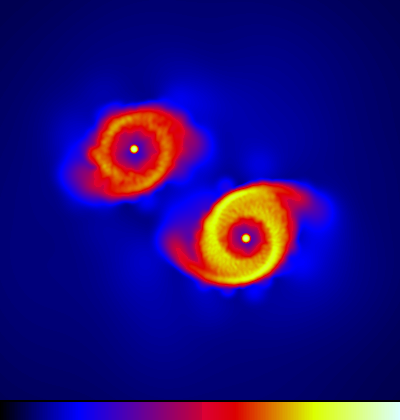Evolution of an Accreting Protobinary System 1This animation shows the evolution of a young binary star system that is still deeply embedded in the molecular cloud core in which it is forming (i.e. a Class 0 object). The binary system accretes gas from its envelope and increases its total mass. It is assumed that the binary formed via fragmentation of the collapsing cloud, although this stage is not modelled. In this calculation, it was assumed that the original molecular cloud core had uniform density and was in solid-body rotation before it began to collapse. This sets the specific angular momentum of the gas that is accreted by the binary after it forms. At the beginning of the calculation the specific angular momentum of the infalling gas is very low. The gas is able to form a circumstellar disc around the primary, but the secondary does not form a disc. Later, as the specific angular momentum of the gas that is falling on to the binary increases, a disc also forms around the secondary. The specific angular momentum of the gas never becomes high enough for a circumbinary disc to form (see the second animation of an accreting protobinary system ). Results from this calculation were published in Bate 2000 (Section 3.3 and Figures 3 and 4). Note that there are not many frames in this animation and, thus, it is more disjointed than most.
|

